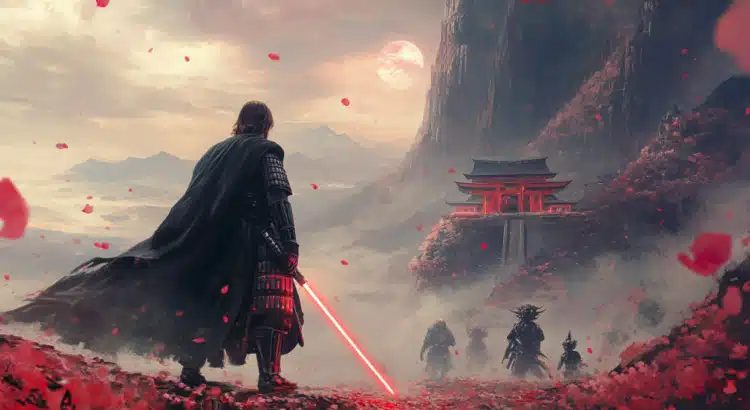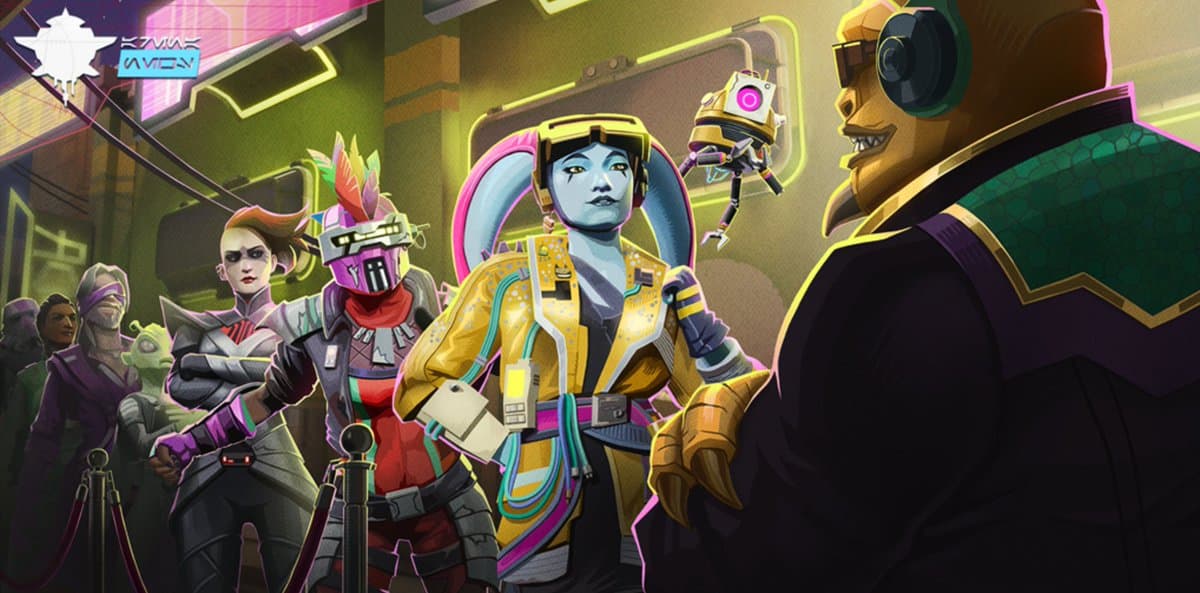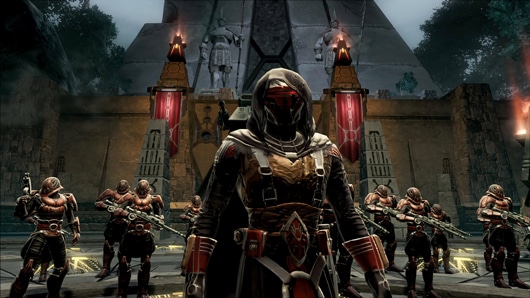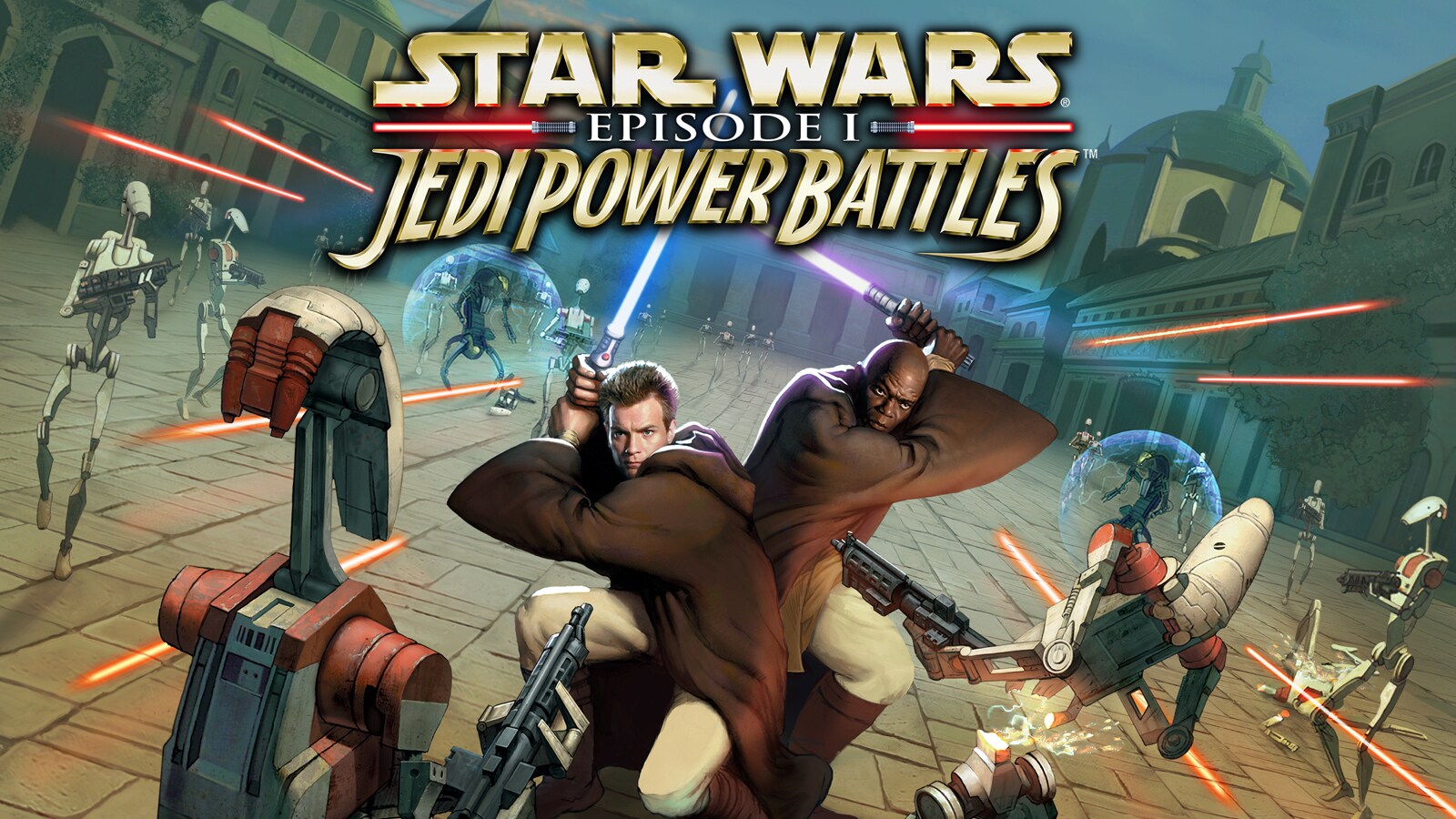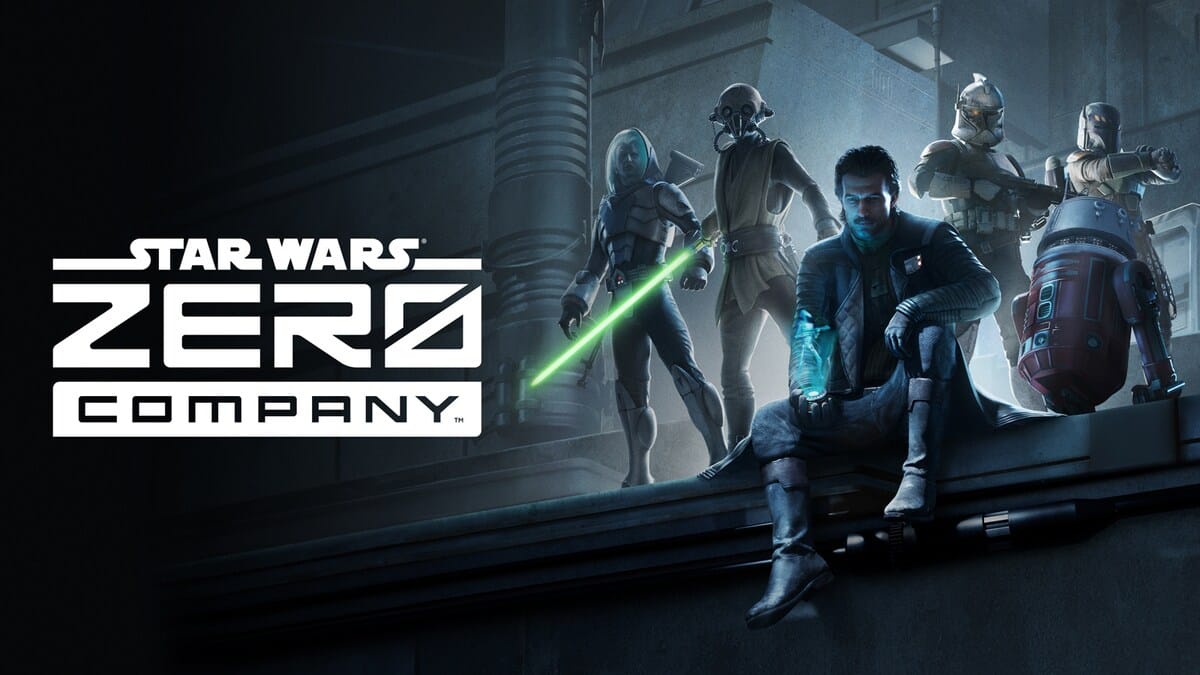Because some Jedi were already halfway to samurai.
As we continue our 5-part series leading up to Star Wars Celebration Japan 2025 (happening April 18–20 in Tokyo), we’re diving into the cultural and visual DNA that connects Star Wars to Japanese history. The connections run deeper than lightsabers and robes—at its core, the galaxy far, far away shares archetypes, values, and mythologies with the world of feudal Japan. The Jedi echo the discipline of the samurai. The Sith carry the tragic pride of fallen warlords. Even the Force itself resonates with Zen-like duality and cosmic harmony.
This time, we’re going full speculative fiction: imagining iconic Star Wars characters reimagined as figures from feudal Japan. If George Lucas drew from Kurosawa’s lens, let’s step all the way through the torii gate and recast the galaxy as if it were ruled by shogun and shinobi. We’re not just swapping outfits—we’re reinterpreting these characters through the lens of Bushidō, ronin lore, and Edo-period storytelling.
It’s not as far-fetched as it sounds. From their robes and swords to their sense of duty and honor, Jedi and Sith already walk the line between monk and warrior. The aesthetics, philosophies, and archetypes of Star Wars fit surprisingly well into the world of shogun, shinobi, and samurai codes.
So here are five characters we think would fit perfectly in a Kurosawa-style epic set in Edo-era Japan. And when you’re done reading, let us know: who would you add to the list?
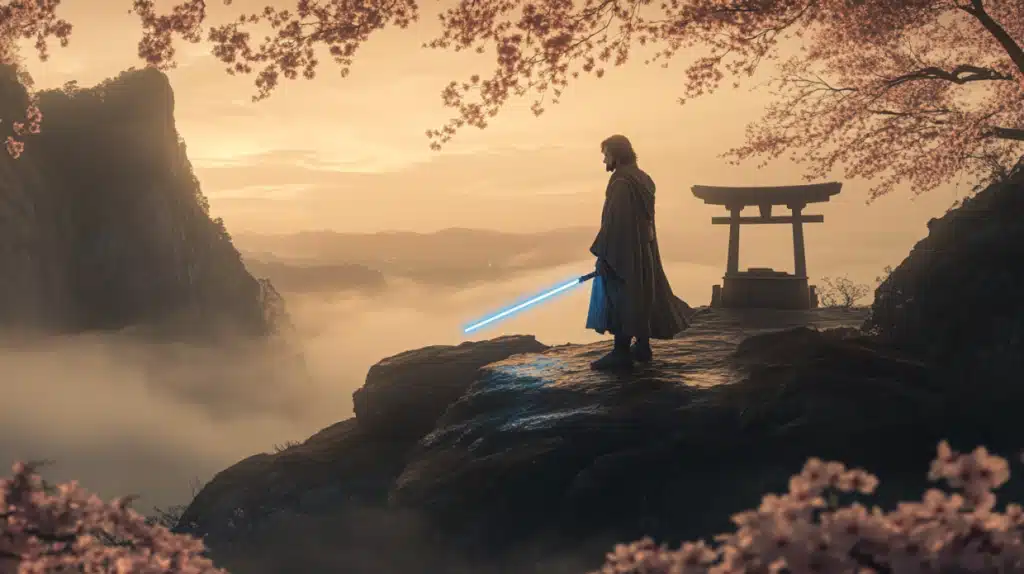
1. Obi-Wan Kenobi – The Ronin Monk
If there’s one Star Wars character who feels plucked straight out of a Kurosawa film, it’s Obi-Wan Kenobi. His journey from respected Jedi General to solitary guardian of the desert mirrors the arc of a classic ronin—a masterless samurai who continues to uphold the code of Bushidō even after losing everything.
In feudal Japan, ronin were often seen as tragic figures: warriors without lords, wandering the countryside, either trying to reclaim their honor or simply survive in a fractured world. Obi-Wan’s exile on Tatooine after Order 66 fits this archetype perfectly. He’s not just hiding—he’s meditating, watching, reflecting. Much like a retired samurai monk who has taken to a mountain temple, Obi-Wan embodies the concept of zanshin—the quiet, alert awareness of a warrior always prepared to act when necessary.
And act he does. When the time comes to protect Luke, Obi-Wan draws his saber with deliberate grace. He doesn’t seek battle but accepts it as part of his duty. His final duel with Darth Vader is reminiscent of those slow, tension-filled showdowns in chanbara films, where every movement carries emotional and philosophical weight.
In his younger years, Obi-Wan would have been seen as a model samurai: loyal to his order, respectful of hierarchy, deeply trained in discipline and combat. But it’s his later life, the ronin era, that makes him such a compelling fit for feudal Japan. He walks alone. He guards the innocent. He teaches when asked. And when he falls, it is not in defeat but in transcendence—offering himself to the Force the way a monk might offer his final breath to the path of enlightenment.
Kenobi the Ronin. Sword sheathed. Eyes clear. Soul intact.
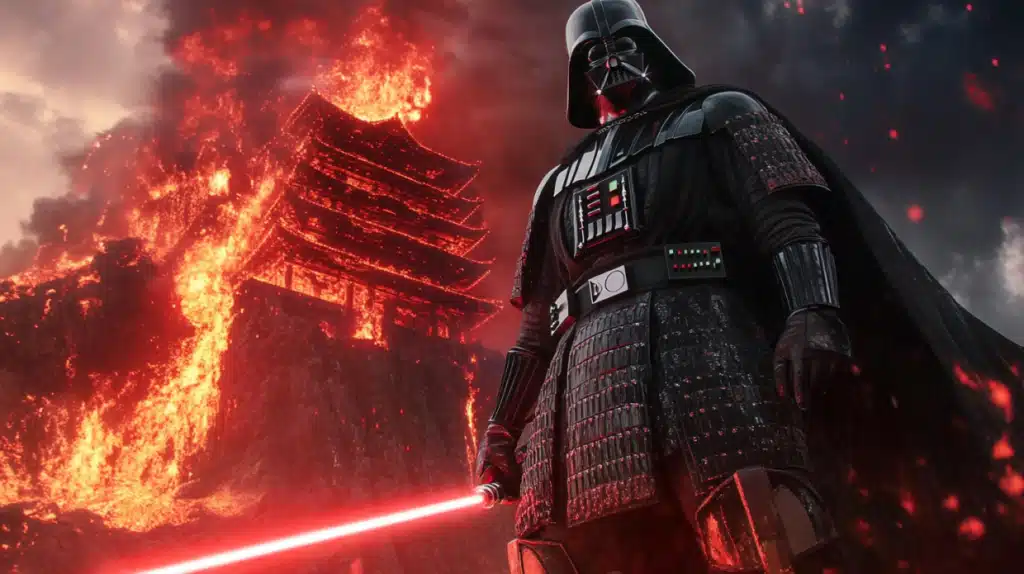
2. Darth Vader – The Fallen Shogun
Towering. Armored. Feared. And once, respected. Darth Vader is the perfect reimagining of a fallen shogun—a military ruler who once fought with honor but succumbed to ambition, tragedy, and authoritarian rule.
In feudal Japan, shoguns held immense power. But history is filled with examples of shogunates that fell to infighting, betrayal, or the thirst for control. Vader’s arc mirrors those warlords who began as noble warriors and descended into tyranny.
Imagine him in full lacquered black armor, his breathing echoing through a quiet palace corridor. His saber—a twisted evolution of a katana—glows with menace. Once a general under a wise emperor (aka the Jedi Order), he’s now seized control and rules with fear. His castle on Mustafar might as well be a volcano-side fortress, filled with shadows, lava, and ancient grudges.
But what makes Vader such a compelling shogun figure isn’t just his power—it’s his past. He wasn’t born a tyrant. He was made one through loss, manipulation, and grief. That’s pure samurai tragedy. Like a daimyo who turns on his own to avenge a perceived dishonor, Vader carries the weight of every life he’s taken—and wears it as armor.
In Edo-era storytelling, such figures often meet poetic ends: undone not by their enemies, but by their own ghosts. Vader’s redemption through Luke is his return—not to the Jedi, but to the bushidō he once followed. He dies not as a warlord, but as a father, reclaiming the honor he lost.
The Shogun falls. But the man beneath the mask finds peace.
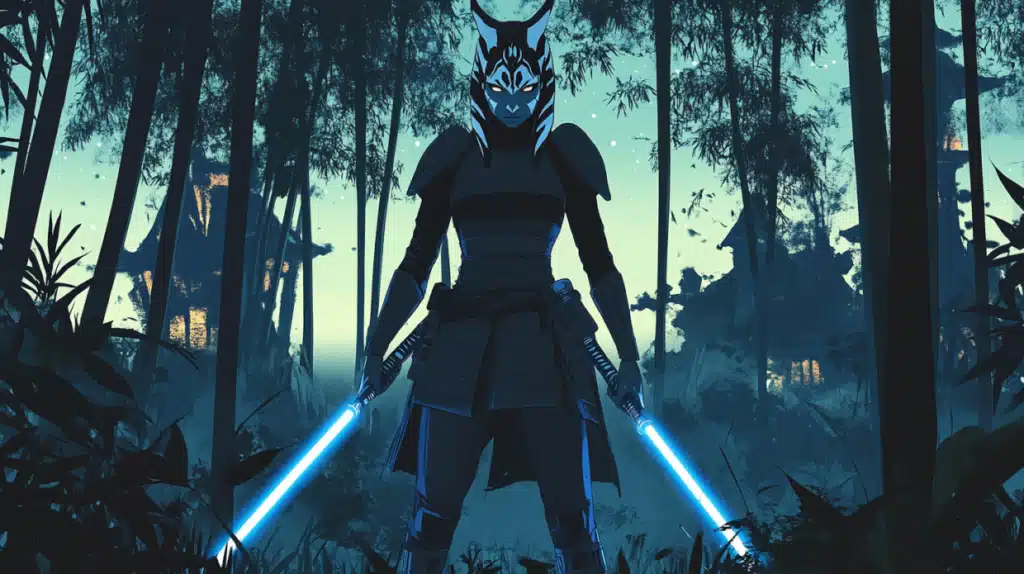
3. Ahsoka Tano – The Shadowy Onna-bugeisha
Ahsoka Tano doesn’t just break molds—she remakes them. In a feudal Japan setting, she’d be the perfect blend of onna-bugeisha (female warrior) and kunoichi (female ninja): trained in the arts of war, adept in stealth, and wholly self-guided.
Historically, onna-bugeisha were noblewomen who took up arms to protect their homes or lead in times of conflict. They were trained in naginata, swordsmanship, and strategy—exactly the kind of martial grace and independence Ahsoka embodies. But unlike many samurai, Ahsoka walks between worlds. She was trained in the Jedi Order (read: samurai academy), but left it behind when its code no longer aligned with her values.
That alone places her firmly in the realm of the freelance warrior, a ronin with shinobi tendencies. In Edo-era fiction, these characters often work in the shadows, taking justice into their own hands and answering only to personal morality. Sounds familiar, doesn’t it?
She moves like a ninja, strikes like a swordswoman, and hides like a ghost. Her dual sabers would easily translate into twin wakizashi or sai-style blades. And her hooded, travel-worn attire already looks like it was plucked from a Japanese historical drama.
In feudal Japan, Ahsoka wouldn’t serve a lord—she’d guard a village, strike down corruption, or train the next generation in secret. She’s the kind of warrior bards would whisper about. Elusive. Skilled. Guided by conviction rather than command.
The shadow with twin blades. A warrior born of honor, not titles.
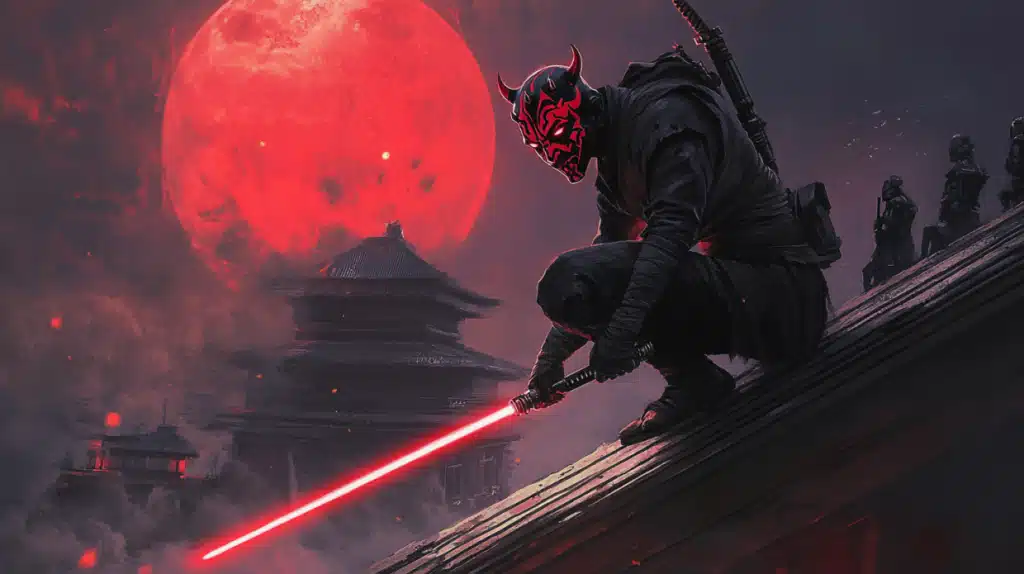
4. Darth Maul – The Rogue Shinobi
Darth Maul was practically born to be a ninja. From his acrobatic fighting style to his silence, vengeance-driven purpose, and stark, intimidating look, Maul is the quintessential shinobi in a Star Wars skin.
In feudal Japan, shinobi were spies, saboteurs, assassins—trained to move unseen and strike without mercy. Maul checks all those boxes. But where most ninja served a master, Maul is a rogue agent. After being betrayed and left for dead, he remakes himself, gathering his own followers, building crime syndicates, and executing plans with surgical precision.
In a Japanese setting, Maul wouldn’t wear a clan’s crest—he’d be the lone wolf prowling through moonlit castles, taking vengeance on the lords who wronged him. His double-bladed lightsaber evokes the naginata or kusarigama—exotic weapons favored by warriors who defy the rules.
His tattoos would carry spiritual and practical significance, his silence the mark of a deadly practitioner of ninpō (the way of stealth). And emotionally? Maul’s pain is his power. Like many ninja in historical fiction, he isn’t evil—he’s tragic. Betrayed, abandoned, and forged into something dangerous.
He exists outside the code. And he makes the code tremble.
A blade in the dark. A ghost from the past. The shinobi who won’t die.
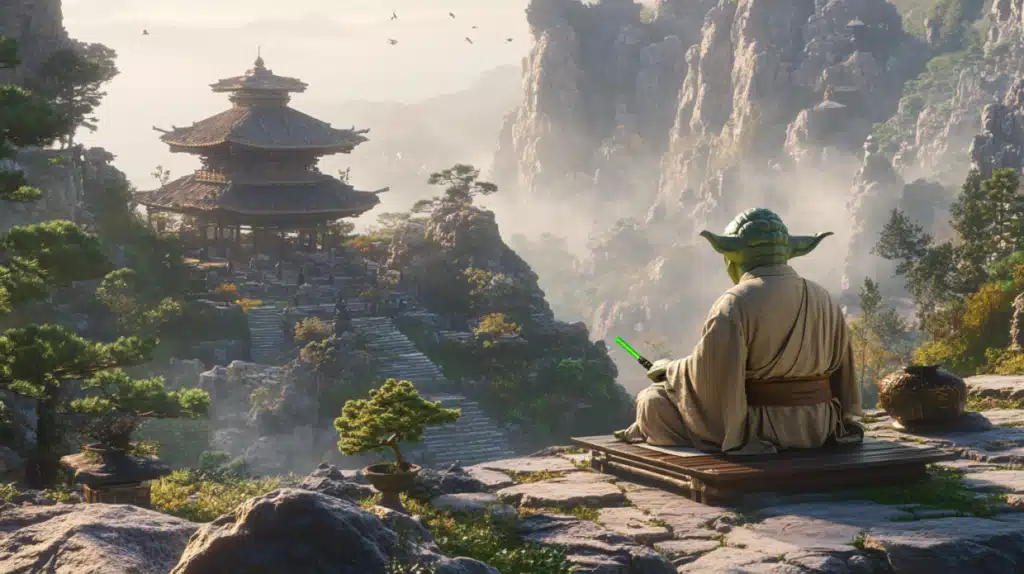
5. Yoda – The Mountain Sage
High in the mountains of Japan, far from the courts of emperors and the chaos of the battlefield, lives the sennin—a mountain sage, part philosopher, part mystic, and part teacher. In the galaxy far, far away, that figure is Yoda.
Yoda’s role as a mentor, spiritual guide, and wielder of ancient wisdom places him in the same tradition as Zen monks and Taoist hermits. Like a Buddhist master who trains young warriors in the art of both sword and soul, Yoda teaches not only how to fight, but how to be.
His dialect—strange but clear—would fit right in among old riddling monks of Japanese folklore. His home, carved into the swamps of Dagobah, mirrors the reclusive retreats of high mountain temples, where students travel great distances to learn a few words of truth. And when he does fight (as seen in Attack of the Clones), it’s with both ferocity and spiritual clarity—a last resort, not a thrill.
In feudal Japan, Yoda would live at the edge of a sacred mountain, visited by only the most sincere warriors. His scrolls? Ancient Jedi texts. His disciples? Future legends.
The blade is sharp, but the mind must be sharper. The mountain whispers: train here.
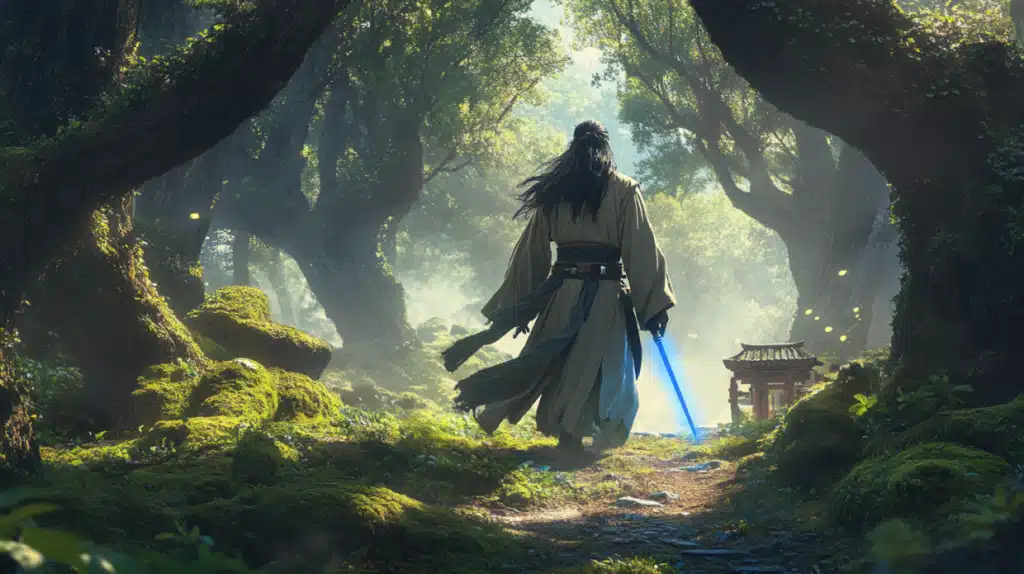
Honorable Mention: Qui-Gon Jinn – The Wandering Seer
While he didn’t make our top five, Qui-Gon Jinn deserves a spotlight of his own. In the context of feudal Japan, Qui-Gon would be the wandering seer—a samurai mystic who listens more to nature and intuition than to the rigid hierarchies of any court. A bit of a heretic, a bit of a prophet, and entirely driven by inner balance.
Much like historical yamabushi—mountain ascetic warriors who practiced Shugendō—Qui-Gon walks a spiritual path that intertwines the mystical with the martial. He believes in the Living Force, in trusting the present moment, and in letting go of control—ideas deeply resonant with Zen Buddhism and Taoist philosophy.
He’s often misunderstood by the Jedi Council, just as many wandering monks and mystic swordsmen were misunderstood by the daimyo and aristocracy. But like them, he’s respected—even feared—for the truths he channels and the strength he carries quietly. In a feudal Japanese epic, he might appear briefly, offer crucial guidance, and disappear into the mist before the final battle—his influence lasting long after he’s gone.
He’s not here to command. He’s here to awaken.
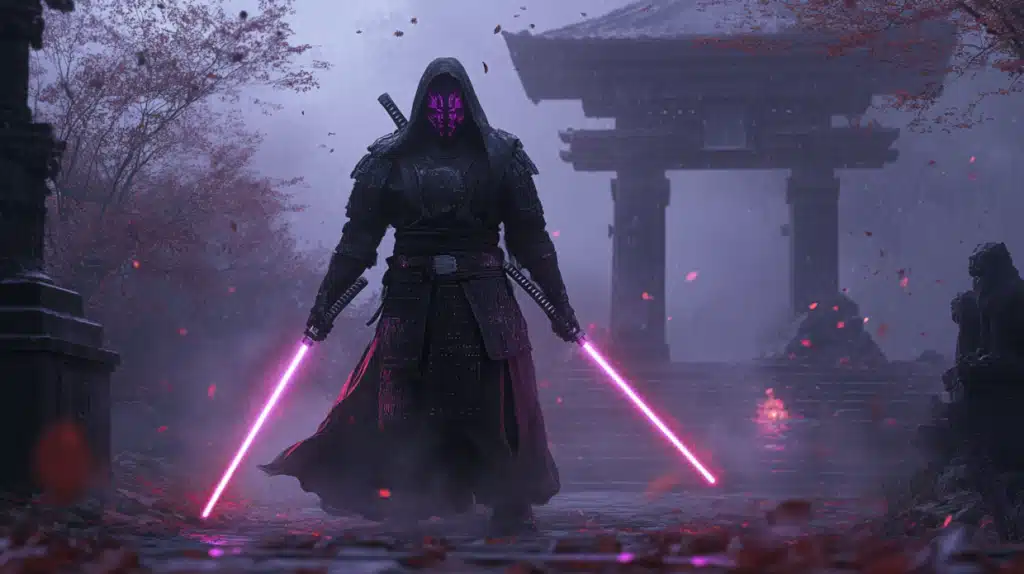
Honorable Mention: Revan – The Masked Warlord-Turned-Monk
No list would be complete without Revan, the iconic warrior-philosopher whose path from Jedi to Sith and back again makes him one of the most complex figures in the Star Wars mythos. In a feudal Japanese retelling, Revan would be a legendary warlord-turned-monk—a masked general who vanished after a brutal civil war, only to reemerge as a wandering ascetic seeking enlightenment.
Like many figures in Sengoku-era Japan, Revan’s mask would be both symbolic and practical: a representation of his fractured identity and a means of severing his ties to the past. His reputation would precede him—villagers whisper of his battlefield prowess, while monks debate the teachings he left behind.
Revan’s dual allegiance and inner conflict place him in the tradition of warrior sages who walked both paths: the sword and the scroll, the battlefield and the temple. He may have once led a rebellion, but now he offers wisdom from a place of silence, regret, and spiritual clarity. Still deadly, but reluctant to fight, Revan’s blade is reserved for those moments when words fail and justice demands.
In feudal Japan, Revan would be the man behind the myth—equal parts shadow and light.
A mask. A past. A purpose reborn.

Final Thought: Who Would You Add?
From stoic ronin to shadowy shinobi, Star Wars characters map surprisingly well onto the archetypes of feudal Japan. As we get closer to Star Wars Celebration Japan 2025, it’s clear that this connection isn’t just visual—it’s mythic.
Who do YOU think would thrive in Edo-era Japan? Would Mace Windu be a palace guard? Would Kylo Ren become a tormented poet-warrior?
Drop your picks in the comments—and may your katana stay sharp, always.


